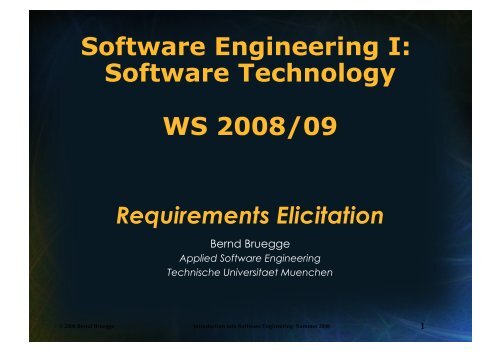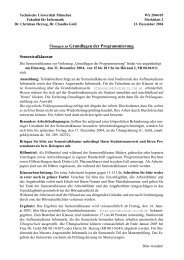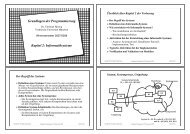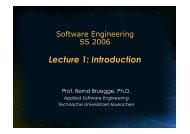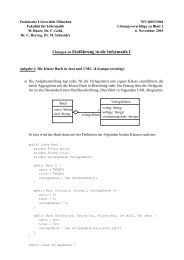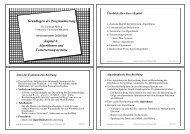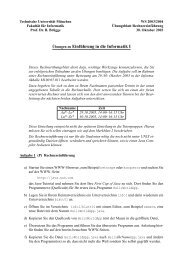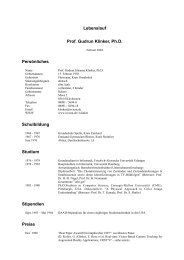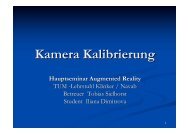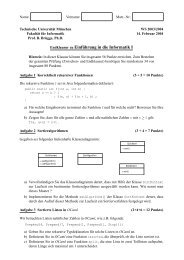Software Engineering I - Chair for Applied Software Engineering
Software Engineering I - Chair for Applied Software Engineering
Software Engineering I - Chair for Applied Software Engineering
Create successful ePaper yourself
Turn your PDF publications into a flip-book with our unique Google optimized e-Paper software.
<strong>Software</strong> <strong>Engineering</strong> I:<br />
<strong>Software</strong> Technology<br />
WS 2008/09<br />
Requirements Elicitation<br />
Bernd Bruegge<br />
<strong>Applied</strong> <strong>Software</strong> <strong>Engineering</strong><br />
Technische Universitaet Muenchen<br />
© 2008 Bernd Bruegge Introduction into <strong>Software</strong> <strong>Engineering</strong> Summer 2008<br />
1
Outline<br />
• Starting Point: <strong>Software</strong> Lifecycle<br />
• Requirements elicitation challenges<br />
• Requirements specification<br />
• Types of requirements<br />
• Validating requirements<br />
• Summary<br />
© 2008 Bernd Bruegge Introduction into <strong>Software</strong> <strong>Engineering</strong> Summer 2008<br />
2
<strong>Software</strong> Lifecycle Definition<br />
• <strong>Software</strong> lifecycle<br />
• Models <strong>for</strong> the development of software<br />
• Set of activities and their dependency<br />
relationships to each other to support the<br />
development of a software system<br />
• Examples:<br />
• Analysis, Design, Implementation,<br />
Testing<br />
• Typical Lifecycle questions:<br />
• Which activities should I select when I develop<br />
software?<br />
• What are the dependencies between<br />
activities?<br />
• How should I schedule the activities?<br />
© 2008 Bernd Bruegge Introduction into <strong>Software</strong> <strong>Engineering</strong> Summer 2008<br />
3
A Typical Example<br />
of <strong>Software</strong> Lifecycle Activities<br />
Requirements<br />
Elicitation<br />
Analysis<br />
System<br />
Design<br />
Detailed<br />
Design<br />
Implemen-<br />
tation<br />
Testing<br />
© 2008 Bernd Bruegge Introduction into <strong>Software</strong> <strong>Engineering</strong> Summer 2008<br />
4
<strong>Software</strong> Lifecycle Activities ...and their models<br />
Requirements<br />
Elicitation<br />
Analysis<br />
System<br />
Design<br />
Detailed<br />
Design<br />
Implemen-<br />
tation<br />
Testing<br />
Use Case<br />
Model<br />
© 2008 Bernd Bruegge Introduction into <strong>Software</strong> <strong>Engineering</strong> Summer 2008<br />
5
<strong>Software</strong> Lifecycle Activities ...and their models<br />
Requirements<br />
Elicitation<br />
Analysis<br />
System<br />
Design<br />
Detailed<br />
Design<br />
Implemen-<br />
tation<br />
Testing<br />
Expressed in<br />
terms of<br />
Use Case<br />
Model<br />
Application<br />
Domain<br />
Objects<br />
© 2008 Bernd Bruegge Introduction into <strong>Software</strong> <strong>Engineering</strong> Summer 2008<br />
6
<strong>Software</strong> Lifecycle Activities ...and their models<br />
Requirements<br />
Elicitation<br />
Analysis<br />
System<br />
Design<br />
Detailed<br />
Design<br />
Implemen-<br />
tation<br />
Testing<br />
Expressed in<br />
terms of<br />
Structured<br />
by<br />
Use Case<br />
Model<br />
Application<br />
Domain<br />
Objects<br />
Subsystems<br />
© 2008 Bernd Bruegge Introduction into <strong>Software</strong> <strong>Engineering</strong> Summer 2008<br />
7
<strong>Software</strong> Lifecycle Activities ...and their models<br />
Requirements<br />
Elicitation<br />
Analysis<br />
System<br />
Design<br />
Detailed<br />
Design<br />
Implemen-<br />
tation<br />
Testing<br />
Expressed in<br />
terms of<br />
Structured<br />
by<br />
Realized by<br />
Use Case<br />
Model<br />
Application<br />
Domain<br />
Objects<br />
Subsystems<br />
Solution<br />
Domain<br />
Objects<br />
© 2008 Bernd Bruegge Introduction into <strong>Software</strong> <strong>Engineering</strong> Summer 2008<br />
8
<strong>Software</strong> Lifecycle Activities ...and their models<br />
Requirements<br />
Elicitation<br />
Analysis<br />
System<br />
Design<br />
Detailed<br />
Design<br />
Implemen-<br />
tation<br />
Testing<br />
Expressed in<br />
terms of<br />
Structured<br />
by<br />
Realized by<br />
Implemented by<br />
Use Case<br />
Model<br />
Application<br />
Domain<br />
Objects<br />
Subsystems<br />
Solution<br />
Domain<br />
Objects<br />
class...<br />
class...<br />
class...<br />
Source<br />
Code<br />
© 2008 Bernd Bruegge Introduction into <strong>Software</strong> <strong>Engineering</strong> Summer 2008<br />
9
<strong>Software</strong> Lifecycle Activities ...and their models<br />
Requirements<br />
Elicitation<br />
Analysis<br />
System<br />
Design<br />
Detailed<br />
Design<br />
Implemen-<br />
tation<br />
Testing<br />
Expressed in<br />
terms of<br />
Structured<br />
by<br />
Realized by<br />
Implemented by<br />
Verified<br />
By<br />
Use Case<br />
Model<br />
Application<br />
Domain<br />
Objects<br />
Subsystems<br />
Solution<br />
Domain<br />
Objects<br />
class...<br />
class...<br />
class...<br />
Source<br />
Code<br />
?<br />
class.... ?<br />
Test<br />
Cases<br />
© 2008 Bernd Bruegge Introduction into <strong>Software</strong> <strong>Engineering</strong> Summer 2008<br />
10
What is the best <strong>Software</strong> Lifecycle?<br />
• Answering this question is the topics of the<br />
lecture on software lifecycle modeling<br />
• For now we assume we have a set of predefined<br />
activities:<br />
• Today we focus on the activity requirements elicitation<br />
© 2008 Bernd Bruegge Introduction into <strong>Software</strong> <strong>Engineering</strong> Summer 2008<br />
11
<strong>Software</strong> Lifecycle Activities<br />
Requirements<br />
Elicitation<br />
Analysis<br />
System<br />
Design<br />
Detailed<br />
Design<br />
Implemen-<br />
tation<br />
Testing<br />
Expressed in<br />
Terms Of<br />
Structured By<br />
Realized By<br />
Implemented<br />
By<br />
Verified<br />
By<br />
Use Case<br />
Model<br />
Application<br />
Domain<br />
Objects<br />
Subsystems<br />
Solution<br />
Domain<br />
Objects<br />
class...<br />
class...<br />
class...<br />
Source<br />
Code<br />
Test<br />
Cases<br />
?<br />
class....?<br />
© 2008 Bernd Bruegge Introduction into <strong>Software</strong> <strong>Engineering</strong> Summer 2008<br />
12
What does the Customer say?<br />
© 2008 Bernd Bruegge Introduction into <strong>Software</strong> <strong>Engineering</strong> Summer 2008<br />
13
First step in identifying the Requirements:<br />
System identification<br />
• Two questions need to be answered:<br />
1. How can we identify the purpose of a system?<br />
2. What is inside, what is outside the system?<br />
• These two questions are answered during<br />
requirements elicitation and analysis<br />
• Requirements elicitation:<br />
• Definition of the system in terms understood by the<br />
customer (“Requirements specification”)<br />
• Analysis:<br />
• Definition of the system in terms understood by the<br />
developer (Technical specification, “Analysis<br />
model”)<br />
• Requirements Process: Contains the activities<br />
Requirements Elicitation and Analysis.<br />
© 2008 Bernd Bruegge Introduction into <strong>Software</strong> <strong>Engineering</strong> Summer 2008<br />
14
Techniques to elicit Requirements<br />
• Bridging the gap between end user and<br />
developer:<br />
• Questionnaires: Asking the end user a list of preselected<br />
questions<br />
• Task Analysis: Observing end users in their<br />
operational environment<br />
• Scenarios: Describe the use of the system as a series<br />
of interactions between a concrete end user and the<br />
system<br />
• Use cases: Abstractions that describe a class of<br />
scenarios.<br />
© 2008 Bernd Bruegge Introduction into <strong>Software</strong> <strong>Engineering</strong> Summer 2008<br />
15
Scenarios<br />
• Scenario (Italian: that which is pinned to the<br />
scenery)<br />
• A synthetic description of an event or series of actions<br />
and events.<br />
• A textual description of the usage of a system. The<br />
description is written from an end user’s point of view.<br />
• A scenario can include text, video, pictures and story<br />
boards. It usually also contains details about the work<br />
place, social situations and resource constraints.<br />
© 2008 Bernd Bruegge Introduction into <strong>Software</strong> <strong>Engineering</strong> Summer 2008<br />
16
More Definitions<br />
• Scenario: “A narrative description of what<br />
people do and experience as they try to make<br />
use of computer systems and applications” [M.<br />
Carroll, Scenario-Based Design, Wiley, 1995]<br />
• A concrete, focused, in<strong>for</strong>mal description of a<br />
single feature of the system used by a single<br />
actor.<br />
© 2008 Bernd Bruegge Introduction into <strong>Software</strong> <strong>Engineering</strong> Summer 2008<br />
17
Scenario-Based Design<br />
Scenarios can have many different uses during the<br />
software lifecycle<br />
• Requirements Elicitation: As-is scenario, visionary<br />
scenario<br />
• Client Acceptance Test: Evaluation scenario<br />
• System Deployment: Training scenario<br />
Scenario-Based Design: The use of scenarios in a<br />
software lifecycle activity<br />
• Scenario-based design is iterative<br />
• Each scenario should be consisered as a work<br />
document to be augmented and rearranged (“iterated<br />
upon”) when the requirements, the client acceptance<br />
criteria or the deployment situation changes.<br />
© 2008 Bernd Bruegge Introduction into <strong>Software</strong> <strong>Engineering</strong> Summer 2008<br />
18
Scenario-based Design<br />
• Focuses on concrete descriptions and particular<br />
instances, not abstract generic ideas<br />
• It is work driven not technology driven<br />
• It is open-ended, it does not try to be complete<br />
• It is in<strong>for</strong>mal, not <strong>for</strong>mal and rigorous<br />
• Is about envisioned outcomes, not about<br />
specified outcomes.<br />
© 2008 Bernd Bruegge Introduction into <strong>Software</strong> <strong>Engineering</strong> Summer 2008<br />
19
Types of Scenarios<br />
• As-is scenario:<br />
• Describes a current situation. Usually used in reengineering<br />
projects. The user describes the system<br />
• Example: Description of Letter-Chess<br />
• Visionary scenario:<br />
• Describes a future system. Usually used in greenfield<br />
engineering and reengineering projects<br />
• Can often not be done by the user or developer alone<br />
• Example: Description of an interactive internetbased<br />
Tic Tac Toe game tournament<br />
• Example: Description - in the year 1954 - of the<br />
Home Computer of the Future.<br />
© 2008 Bernd Bruegge Introduction into <strong>Software</strong> <strong>Engineering</strong> Summer 2008<br />
20
A Visionary Scenario (1954): The Home<br />
Computer in 2004<br />
© 2008 Bernd Bruegge Introduction into <strong>Software</strong> <strong>Engineering</strong> Summer 2008<br />
21
Additional Types of Scenarios (2)<br />
• Evaluation scenario:<br />
• Description of a user task against which the system is<br />
to be evaluated.<br />
• Example: Four users (two novice, two experts) play<br />
in a TicTac Toe tournament in ARENA.<br />
• Training scenario:<br />
• A description of the step by step instructions that guide<br />
a novice user through a system<br />
• Example: How to play Tic Tac Toe in the ARENA<br />
Game Framework.<br />
© 2008 Bernd Bruegge Introduction into <strong>Software</strong> <strong>Engineering</strong> Summer 2008<br />
22
How do we find scenarios?<br />
• Don’t expect the client to be verbal if the system<br />
does not exist<br />
• Client understands problem domain, not the solution<br />
domain.<br />
• Don’t wait <strong>for</strong> in<strong>for</strong>mation even if the system<br />
exists<br />
• “What is obvious does not need to be said”<br />
• Engage in a dialectic approach<br />
• You help the client to <strong>for</strong>mulate the requirements<br />
• The client helps you to understand the requirements<br />
• The requirements evolve while the scenarios are being<br />
developed<br />
© 2008 Bernd Bruegge Introduction into <strong>Software</strong> <strong>Engineering</strong> Summer 2008<br />
23
Heuristics <strong>for</strong> finding scenarios<br />
• Ask yourself or the client the following questions:<br />
• What are the primary tasks that the system needs to<br />
per<strong>for</strong>m?<br />
• What data will the actor create, store, change, remove or<br />
add in the system?<br />
• What external changes does the system need to know<br />
about?<br />
• What changes or events will the actor of the system need<br />
to be in<strong>for</strong>med about?<br />
• However, don’t rely on questions and<br />
questionnaires alone<br />
• Insist on task observation if the system already<br />
exists (interface engineering or reengineering)<br />
• Ask to speak to the end user, not just to the client<br />
• Expect resistance and try to overcome it.<br />
© 2008 Bernd Bruegge Introduction into <strong>Software</strong> <strong>Engineering</strong> Summer 2008<br />
24
Scenario example: Warehouse on Fire<br />
• Bob, driving down main street in his patrol car notices<br />
smoke coming out of a warehouse. His partner, Alice,<br />
reports the emergency from her car.<br />
• Alice enters the address of the building into her wearable<br />
computer , a brief description of its location (i.e., north<br />
west corner), and an emergency level.<br />
• She confirms her input and waits <strong>for</strong> an acknowledgment.<br />
• John, the dispatcher, is alerted to the emergency by a<br />
beep of his workstation. He reviews the in<strong>for</strong>mation<br />
submitted by Alice and acknowledges the report. He<br />
allocates a fire unit and sends the estimated arrival time<br />
(ETA) to Alice.<br />
• Alice received the acknowledgment and the ETA.<br />
© 2008 Bernd Bruegge Introduction into <strong>Software</strong> <strong>Engineering</strong> Summer 2008<br />
25
Observations about Warehouse on Fire<br />
Scenario<br />
• Concrete scenario<br />
• Describes a single instance of reporting a fire<br />
incident.<br />
• Does not describe all possible situations in<br />
which a fire can be reported.<br />
• Participating actors<br />
• Bob, Alice and John<br />
© 2008 Bernd Bruegge Introduction into <strong>Software</strong> <strong>Engineering</strong> Summer 2008<br />
26
After the scenarios are <strong>for</strong>mulated<br />
• Find all the use cases in the scenario that<br />
specify all instances of how to report a fire<br />
• Example: “Report Emergency“ in the first paragraph of<br />
the scenario is a candidate <strong>for</strong> a use case<br />
• Describe each of these use cases in more detail<br />
• Participating actors<br />
• Describe the entry condition<br />
• Describe the flow of events<br />
• Describe the exit condition<br />
• Describe exceptions<br />
• Describe nonfunctional requirements<br />
© 2008 Bernd Bruegge Introduction into <strong>Software</strong> <strong>Engineering</strong> Summer 2008<br />
27
Use Case Model <strong>for</strong> Incident Management<br />
FieldOfficer<br />
Dispatcher<br />
OpenIncident<br />
ReportEmergency<br />
AllocateResources<br />
© 2008 Bernd Bruegge Introduction into <strong>Software</strong> <strong>Engineering</strong> Summer 2008<br />
28
How to find Use Cases<br />
• Select a narrow vertical slice of the system (i.e.<br />
one scenario)<br />
• Discuss it in detail with the user to understand the<br />
user’s preferred style of interaction<br />
• Select a horizontal slice (i.e. many scenarios) to<br />
define the scope of the system.<br />
• Discuss the scope with the user<br />
• Use illustrative prototypes (mock-ups) as visual<br />
support<br />
• Find out what the user does<br />
• Task observation (Good)<br />
• Questionnaires (Bad)<br />
© 2008 Bernd Bruegge Introduction into <strong>Software</strong> <strong>Engineering</strong> Summer 2008<br />
29
Use Case Example: ReportEmergency<br />
• Use case name: ReportEmergency<br />
• Participating Actors:<br />
• Field Officer (Bob and Alice in the Scenario)<br />
• Dispatcher (John in the Scenario)<br />
• Exceptions:<br />
• The FieldOfficer is notified immediately if the<br />
connection between terminal and central is lost.<br />
• The Dispatcher is notified immediately if the connection<br />
between a FieldOfficer and central is lost.<br />
• Flow of Events: on next slide.<br />
• Nonfunctional Requirements:<br />
• The FieldOfficer’s report is acknowledged within 30<br />
seconds. The selected response arrives no later than<br />
30 seconds after it is sent by the Dispatcher.<br />
© 2008 Bernd Bruegge Introduction into <strong>Software</strong> <strong>Engineering</strong> Summer 2008<br />
30
Use Case Example: ReportEmergency<br />
Flow of Events<br />
1. The FieldOfficer activates the “Report Emergency”<br />
function of her terminal. FRIEND responds by<br />
presenting a <strong>for</strong>m to the officer.<br />
2. The FieldOfficer fills the <strong>for</strong>m, by selecting the<br />
emergency level, type, location, and brief<br />
description of the situation. The FieldOfficer also<br />
describes a response to the emergency situation.<br />
Once the <strong>for</strong>m is completed, the FieldOfficer<br />
submits the <strong>for</strong>m, and the Dispatcher is notified.<br />
3. The Dispatcher creates an Incident in the database<br />
by invoking the OpenIncident use case. He selects<br />
a response and acknowledges the report.<br />
4. The FieldOfficer receives the acknowledgment and<br />
the selected response.<br />
© 2008 Bernd Bruegge Introduction into <strong>Software</strong> <strong>Engineering</strong> Summer 2008<br />
31
Another Example: Allocate a Resource<br />
• Actors:<br />
• Field Supervisor: This is the official at the<br />
emergency site.<br />
• Resource Allocator: The Resource Allocator is<br />
responsible <strong>for</strong> the commitment and<br />
decommitment of the Resources managed by<br />
the FRIEND system.<br />
• Dispatcher: A Dispatcher enters, updates, and<br />
removes Emergency Incidents, Actions, and<br />
Requests in the system. The Dispatcher also<br />
closes Emergency Incidents.<br />
• Field Officer: Reports accidents from the Field<br />
© 2008 Bernd Bruegge Introduction into <strong>Software</strong> <strong>Engineering</strong> Summer 2008<br />
32
Allocate a Resource (cont’d)<br />
• Use case name: AllocateResources<br />
• Participating Actors:<br />
Field Officer (Bob and Alice in the Scenario)<br />
Dispatcher (John in the Scenario)<br />
Resource Allocator and Field Supervisor<br />
• Entry Condition:<br />
The Resource Allocator has selected an available resource<br />
• Flow of Events:<br />
1. The Resource Allocator selects an Emergency Incident<br />
2. The Resource is committed to the Emergency Incident<br />
• Exit Condition:<br />
The use case terminates when the resource is committed<br />
The selected Resource is unavailable to other Requests.<br />
• Special Requirements:<br />
The Field Supervisor is responsible <strong>for</strong> managing Resources<br />
© 2008 Bernd Bruegge Introduction into <strong>Software</strong> <strong>Engineering</strong> Summer 2008<br />
33
Order of steps when <strong>for</strong>mulating use cases<br />
• First step: Name the use case<br />
• Use case name: ReportEmergency<br />
• Second step: Find the actors<br />
• Generalize the concrete names (“Bob”) to participating<br />
actors (“Field officer”)<br />
• Participating Actors:<br />
• Field Officer (Bob and Alice in the Scenario)<br />
• Dispatcher (John in the Scenario)<br />
• Third step: Concentrate on the flow of events<br />
• Start with in<strong>for</strong>mal natural language<br />
© 2008 Bernd Bruegge Introduction into <strong>Software</strong> <strong>Engineering</strong> Summer 2008<br />
34
Requirements Elicitation: Difficulties and<br />
Challenges<br />
• Communicate accurately about the domain and<br />
the system<br />
• People with different backgrounds must collaborate to<br />
bridge the gap between end users and developers<br />
• Client and end users have application domain<br />
knowledge<br />
• Developers have solution domain knowledge<br />
• Identify an appropriate system (Defining the<br />
system boundary)<br />
• Provide an unambiguous specification<br />
• Leave out unintended features<br />
=> 3 Examples.<br />
© 2008 Bernd Bruegge Introduction into <strong>Software</strong> <strong>Engineering</strong> Summer 2008<br />
35
Defining the System Boundary is difficult<br />
What do you see here?<br />
© 2008 Bernd Bruegge Introduction into <strong>Software</strong> <strong>Engineering</strong> Summer 2008<br />
36
Defining the System Boundary is difficult<br />
What do you see now?<br />
© 2008 Bernd Bruegge Introduction into <strong>Software</strong> <strong>Engineering</strong> Summer 2008<br />
37
Defining the System Boundary is difficult<br />
What do you see now?<br />
© 2008 Bernd Bruegge Introduction into <strong>Software</strong> <strong>Engineering</strong> Summer 2008<br />
38
Example of an Ambiguous Specification<br />
During a laser experiment, a laser beam was<br />
directed from earth to a mirror on the Space<br />
Shuttle Discovery<br />
The laser beam was supposed to be reflected<br />
back towards a mountain top 10,023 feet high<br />
The operator entered the elevation as “10023”<br />
The light beam never hit the mountain top<br />
What was the problem?<br />
The computer interpreted the number in miles...<br />
© 2008 Bernd Bruegge Introduction into <strong>Software</strong> <strong>Engineering</strong> Summer 2008<br />
39
Example of an Unintended Feature<br />
From the News: London underground train<br />
leaves station without driver!<br />
What happened?<br />
• A passenger door was stuck and did not close<br />
• The driver left his train to close the passenger<br />
door<br />
• He left the driver door open<br />
• He relied on the specification that said the train<br />
does not move if at least one door is open<br />
• When he shut the passenger door,<br />
the train left the station without him<br />
• The driver door was not treated<br />
as a door in the source code!<br />
© 2008 Bernd Bruegge Introduction into <strong>Software</strong> <strong>Engineering</strong> Summer 2008<br />
40
Requirements Process<br />
:problem<br />
statement<br />
Requirements<br />
elicitation<br />
Requirements<br />
Specification<br />
:nonfunctional<br />
requirements<br />
:functional<br />
model<br />
Analysis<br />
Analysis Model<br />
:dynamic model<br />
UML Activity Diagram<br />
:analysis object<br />
model<br />
© 2008 Bernd Bruegge Introduction into <strong>Software</strong> <strong>Engineering</strong> Summer 2008<br />
41
Requirements Specification vs Analysis<br />
Model<br />
Both focus on the requirements from the user’s<br />
view of the system<br />
• The requirements specification uses natural<br />
language (derived from the problem statement)<br />
• We provide you with a template.<br />
• The analysis model uses a <strong>for</strong>mal or semi-<strong>for</strong>mal<br />
notation<br />
• We use UML.<br />
© 2008 Bernd Bruegge Introduction into <strong>Software</strong> <strong>Engineering</strong> Summer 2008<br />
42
Types of Requirements<br />
• Functional requirements<br />
• Describe the interactions between the system and its<br />
environment independent from the implementation<br />
“An operator must be able to define a new game. “<br />
• Nonfunctional requirements<br />
• Aspects not directly related to functional behavior.<br />
“The response time must be less than 1 second”<br />
• Constraints<br />
• Imposed by the client or the environment<br />
• “The implementation language must be Java “<br />
• Called “Pseudo requirements” in the text book.<br />
© 2008 Bernd Bruegge Introduction into <strong>Software</strong> <strong>Engineering</strong> Summer 2008<br />
43
Functional vs. Nonfunctional Requirements<br />
Functional Requirements<br />
• Describe user tasks<br />
that the system needs<br />
to support<br />
• Phrased as actions<br />
“Advertise a new league”<br />
“Schedule tournament”<br />
“Notify an interest group”<br />
Nonfunctional Requirements<br />
• Describe properties of the<br />
system or the domain<br />
• Phrased as constraints or<br />
negative assertions<br />
“All user inputs should be<br />
acknowledged within 1<br />
second”<br />
“A system crash should not<br />
result in data loss”.<br />
© 2008 Bernd Bruegge Introduction into <strong>Software</strong> <strong>Engineering</strong> Summer 2008<br />
44
Types of Nonfunctional Requirements<br />
Quality requirements<br />
© 2008 Bernd Bruegge Introduction into <strong>Software</strong> <strong>Engineering</strong> Summer 2008<br />
Constraints or<br />
Pseudo requirements<br />
45
Types of Nonfunctional Requirements<br />
• Usability<br />
• Reliability<br />
• Robustness<br />
• Safety<br />
• Per<strong>for</strong>mance<br />
• Response time<br />
• Scalability<br />
• Throughput<br />
• Availability<br />
• Supportability<br />
• Adaptability<br />
• Maintainability<br />
Quality requirements<br />
© 2008 Bernd Bruegge Introduction into <strong>Software</strong> <strong>Engineering</strong> Summer 2008<br />
Constraints or<br />
Pseudo requirements<br />
46
Types of Nonfunctional Requirements<br />
• Usability<br />
• Reliability<br />
• Robustness<br />
• Safety<br />
• Per<strong>for</strong>mance<br />
• Response time<br />
• Scalability<br />
• Throughput<br />
• Availability<br />
• Supportability<br />
• Adaptability<br />
• Maintainability<br />
Quality requirements<br />
• Implementation<br />
• Interface<br />
• Operation<br />
• Packaging<br />
© 2008 Bernd Bruegge Introduction into <strong>Software</strong> <strong>Engineering</strong> Summer 2008<br />
• Legal<br />
• Licensing (GPL, LGPL)<br />
• Certification<br />
• Regulation<br />
Constraints or<br />
Pseudo requirements<br />
47
Task<br />
• Find definitions <strong>for</strong> all the nonfunctional<br />
requirements on the previous slide and learn<br />
them by heart<br />
• Understand their meaning and scope (their<br />
applicability).<br />
© 2008 Bernd Bruegge Introduction into <strong>Software</strong> <strong>Engineering</strong> Summer 2008<br />
48
Some Quality Requirements Definitions<br />
• Usability <br />
• The ease with which actors can use a system to per<strong>for</strong>m a function<br />
• Usability is one of the most frequently misused terms ((“The system is<br />
easy to use”)<br />
• Usability must be measurable, otherwise it is marketing<br />
• Example: Specification of the number of steps – the measure! -<br />
to per<strong>for</strong>m a internet-based purchase with a web browser<br />
• Robustness: The ability of a system to maintain a function <br />
• even if the user enters a wrong input<br />
• even if there are changes in the environment<br />
• Example: The system can tolerate temperatures up to 90 C<br />
• Availability: The ratio of the expected uptime of a system to<br />
the aggregate of the expected up and down time<br />
• Example: The system is down not more than 5 minutes per week.
Nonfunctional Requirements: Examples<br />
• “Spectators must be able to watch a match<br />
without prior registration and without prior<br />
knowledge of the match.”<br />
Usability Requirement<br />
• “The system must support 10 parallel<br />
tournaments”<br />
Per<strong>for</strong>mance Requirement<br />
• “The operator must be able to add new games<br />
without modifications to the existing system.”<br />
Supportability Requirement<br />
© 2008 Bernd Bruegge Introduction into <strong>Software</strong> <strong>Engineering</strong> Summer 2008<br />
50
What should not be in the Requirements?<br />
• System structure, implementation technology<br />
• Development methodology<br />
• Parnas, How to fake the software development process<br />
• Development environment<br />
• Implementation language<br />
• Reusability<br />
• It is desirable that none of these above are<br />
constrained by the client.<br />
© 2008 Bernd Bruegge Introduction into <strong>Software</strong> <strong>Engineering</strong> Summer 2008<br />
51
Requirements Validation<br />
Requirements validation is a quality assurance<br />
step, usually per<strong>for</strong>med after requirements<br />
elicitation or after analysis<br />
• Correctness:<br />
• The requirements represent the client’s view<br />
• Completeness:<br />
• All possible scenarios, in which the system can be used,<br />
are described<br />
• Consistency:<br />
• There are no requirements that contradict each other.<br />
© 2008 Bernd Bruegge Introduction into <strong>Software</strong> <strong>Engineering</strong> Summer 2008<br />
52
Requirements Validation (2)<br />
• Clarity:<br />
• Requirements can only be interpreted in one way<br />
• Realism:<br />
• Requirements can be implemented and delivered<br />
• Traceability:<br />
• Each system behavior can be traced to a set of<br />
functional requirements<br />
• Problems with requirements validation:<br />
• Requirements change quickly during requirements<br />
elicitation<br />
• Inconsistencies are easily added with each change<br />
• Tool support is needed!<br />
© 2008 Bernd Bruegge Introduction into <strong>Software</strong> <strong>Engineering</strong> Summer 2008<br />
53
We can specify Requirements <strong>for</strong><br />
“Requirements Management”<br />
• Functional requirements:<br />
• Store the requirements in a shared repository<br />
• Provide multi-user access to the requirements<br />
• Automatically create a specification document<br />
from the requirements<br />
• Allow change management of the requirements<br />
• Provide traceability of the requirements throughout<br />
the artifacts of the system.<br />
© 2008 Bernd Bruegge Introduction into <strong>Software</strong> <strong>Engineering</strong> Summer 2008<br />
54
Tools <strong>for</strong> Requirements Management (2)<br />
DOORS (Telelogic)<br />
• Multi-plat<strong>for</strong>m requirements management tool, <strong>for</strong><br />
teams working in the same geographical location.<br />
DOORS XT <strong>for</strong> distributed teams<br />
RequisitePro (IBM/Rational)<br />
• Integration with MS Word<br />
• Project-to-project comparisons via XML baselines<br />
RD-Link (http://www.ring-zero.com)<br />
• Provides traceability between RequisitePro & Telelogic<br />
DOORS<br />
Unicase (http://unicase.org)<br />
• Research tool at our chair <strong>for</strong> the collaborative<br />
development of system models<br />
• Participants can be geographically distributed.<br />
© 2008 Bernd Bruegge Introduction into <strong>Software</strong> <strong>Engineering</strong> Summer 2008<br />
55
Types of Requirements Elicitation<br />
• Greenfield <strong>Engineering</strong><br />
• Development starts from scratch, no prior system<br />
exists, requirements come from end users and clients<br />
• Triggered by user needs<br />
• Re-engineering<br />
• Re-design and/or re-implementation of an existing<br />
system using newer technology<br />
• Triggered by technology enabler<br />
• Interface <strong>Engineering</strong><br />
• Provision of existing services in a new environment<br />
• Triggered by technology enabler or new market needs<br />
© 2008 Bernd Bruegge Introduction into <strong>Software</strong> <strong>Engineering</strong> Summer 2008<br />
56
Prioritizing requirements<br />
• High priority<br />
• Addressed during analysis, design, and implementation<br />
• A high-priority feature must be demonstrated<br />
• Medium priority<br />
• Addressed during analysis and design<br />
• Usually demonstrated in the second iteration<br />
• Low priority<br />
• Addressed only during analysis<br />
• Illustrates how the system is going to be used in the<br />
future with not yet available technology<br />
© 2008 Bernd Bruegge Introduction into <strong>Software</strong> <strong>Engineering</strong> Summer 2008<br />
57
Requirements Analysis Document Template<br />
1. Introduction<br />
2. Current system<br />
3. Proposed system<br />
3.1 Overview<br />
3.2 Functional requirements<br />
3.3 Nonfunctional requirements<br />
3.4 Constraints (“Pseudo requirements”)<br />
3.5 System models<br />
3.5.1 Scenarios<br />
3.5.2 Use case model<br />
3.5.3 Object model<br />
3.5.3.1 Data dictionary<br />
3.5.3.2 Class diagrams<br />
3.5.4 Dynamic models<br />
3.5.5 User interface<br />
4. Glossary<br />
© 2008 Bernd Bruegge Introduction into <strong>Software</strong> <strong>Engineering</strong> Summer 2008<br />
58
Nonfunctional Requirements<br />
(Questions to overcome “Writers block”)<br />
User interface and human factors<br />
• What type of user will be using the system?<br />
• Will more than one type of user be using the<br />
system?<br />
• What training will be required <strong>for</strong> each type of<br />
user?<br />
• Is it important that the system is easy to learn?<br />
• Should users be protected from making errors?<br />
• What input/output devices are available<br />
Documentation<br />
• What kind of documentation is required?<br />
• What audience is to be addressed by each<br />
document?<br />
© 2008 Bernd Bruegge Introduction into <strong>Software</strong> <strong>Engineering</strong> Summer 2008<br />
59
Nonfunctional Requirements (2)<br />
Hardware considerations<br />
• What hardware is the proposed system to be used on?<br />
• What are the characteristics of the target hardware,<br />
including memory size and auxiliary storage space?<br />
Per<strong>for</strong>mance characteristics<br />
• Are there speed, throughput, response time constraints<br />
on the system?<br />
• Are there size or capacity constraints on the data to be<br />
processed by the system?<br />
Error handling and extreme conditions<br />
• How should the system respond to input errors?<br />
• How should the system respond to extreme conditions?<br />
© 2008 Bernd Bruegge Introduction into <strong>Software</strong> <strong>Engineering</strong> Summer 2008<br />
60
Nonfunctional Requirements (3)<br />
System interfacing<br />
• Is input coming from systems outside the proposed<br />
system?<br />
• Is output going to systems outside the proposed system?<br />
• Are there restrictions on the <strong>for</strong>mat or medium that must<br />
be used <strong>for</strong> input or output?<br />
Quality issues<br />
• What are the requirements <strong>for</strong> reliability?<br />
• Must the system trap faults?<br />
• What is the time <strong>for</strong> restarting the system after a failure?<br />
• Is there an acceptable downtime per 24-hour period?<br />
• Is it important that the system be portable?<br />
© 2008 Bernd Bruegge Introduction into <strong>Software</strong> <strong>Engineering</strong> Summer 2008<br />
61
Nonfunctional Requirements (4)<br />
System Modifications<br />
• What parts of the system are likely to be modified?<br />
• What sorts of modifications are expected?<br />
Physical Environment<br />
• Where will the target equipment operate?<br />
• Is the target equipment in one or several locations?<br />
• Will the environmental conditions be ordinary?<br />
Security Issues<br />
• Must access to data or the system be controlled?<br />
• Is physical security an issue?<br />
© 2008 Bernd Bruegge Introduction into <strong>Software</strong> <strong>Engineering</strong> Summer 2008<br />
62
Nonfunctional Requirements (5)<br />
Resources and Management Issues<br />
• How often will the system be backed up?<br />
• Who will be responsible <strong>for</strong> the back up?<br />
• Who is responsible <strong>for</strong> system installation?<br />
• Who will be responsible <strong>for</strong> system maintenance?<br />
© 2008 Bernd Bruegge Introduction into <strong>Software</strong> <strong>Engineering</strong> Summer 2008<br />
63
Example: Heathrow Luggage System<br />
• On April 5, 2008 a system update was per<strong>for</strong>med<br />
to upgrade the baggage handling:<br />
• 50 flights were canceled on the day of the update<br />
• A “Bag Backlog” of 20,000 bags was produced (Naomi<br />
Campbell had a fit and was arrested)<br />
• The bags were resorted in Italy and eventually sent to the<br />
passengers via Federal Express<br />
• What happened? Initial explanation:<br />
• Computer failure in the high storage bay area in<br />
combination with shortage of personal<br />
© 2008 Bernd Bruegge Introduction into <strong>Software</strong> <strong>Engineering</strong> Summer 2008<br />
64
Exercise<br />
• Reverse engineer the requirements <strong>for</strong> the<br />
Heathrow luggage system<br />
• Use the requirements analysis document template<br />
• Use available in<strong>for</strong>mation on the internet.<br />
• Questions to ask:<br />
• How are the bags stored after passengers have checked,<br />
but be<strong>for</strong>e they enter the plane?<br />
• How are the bags retrieved from the storage area?<br />
• What about existing luggage systems (“legacy systems”)?<br />
• Scalability: How many users should the new luggage<br />
system support? How can this be tested be<strong>for</strong>e<br />
deployment?<br />
• Throughput: How many suit cases/hour need to be<br />
supported?<br />
© 2008 Bernd Bruegge Introduction into <strong>Software</strong> <strong>Engineering</strong> Summer 2008<br />
65
Bonus Question<br />
• What changes to the requirements should have<br />
been done to avoid the Heathrow desaster?<br />
© 2008 Bernd Bruegge Introduction into <strong>Software</strong> <strong>Engineering</strong> Summer 2008<br />
66
Exercise Solution<br />
• Available in<strong>for</strong>mation on the internet. Examples<br />
• http://blogs.zdnet.com/projectfailures/?p=610<br />
• http://www.bloomberg.com/apps/news?<br />
pid=conewsstory&refer=conews&tkr=FDX:US&sid=aY4IqhBRcytA<br />
• Examples of requirements:<br />
• Automate the processing of No-Show passengers<br />
• Use a high bay storage area (“high rack warehouse”)<br />
• Provide a chaotic storage capability<br />
• Combine two existing luggage systems (“legacy<br />
systems”): Early (hours be<strong>for</strong>e) and last minute checkins<br />
• The system must be tested with 2500 volunteers<br />
• The throughput must be at least 12000 suitcases/hour.<br />
© 2008 Bernd Bruegge Introduction into <strong>Software</strong> <strong>Engineering</strong> Summer 2008<br />
67
Additional Readings<br />
• John M. Carrol, Scenario-Based Design: Envisioning Work and<br />
Technology in System Development, John Wiley, 1995<br />
• Usability <strong>Engineering</strong>: Scenario-Based Development of Human<br />
Computer Interaction, Morgan Kaufman, 2001<br />
• A (almost complete) list of Requirements Management Tools:<br />
• http://www.jiludwig.com/Requirements_Management_Tools.html<br />
• In<strong>for</strong>mation about the Heathrow Luggage System:<br />
• http://blogs.zdnet.com/projectfailures/?p=610<br />
• http://www.bloomberg.com/apps/news?<br />
pid=conewsstory&refer=conews&tkr=FDX:US&sid=aY4IqhBRcytA<br />
• Panne auf Flughöhe Null (Spiegel):<br />
http://www.spiegel.de/reise/aktuell/0,1518,544768,00.html<br />
• Zurück in das rotierende Chaos (FAZ):<br />
http://www.faz.net/s/Rub7F4BEE0E0C39429A8565089709B70C44/<br />
Doc~EC1120B27386C4E34A67A5EE8E5523433~ATpl~Ecommon~Scon<br />
tent.html<br />
© 2008 Bernd Bruegge Introduction into <strong>Software</strong> <strong>Engineering</strong> Summer 2008<br />
68


